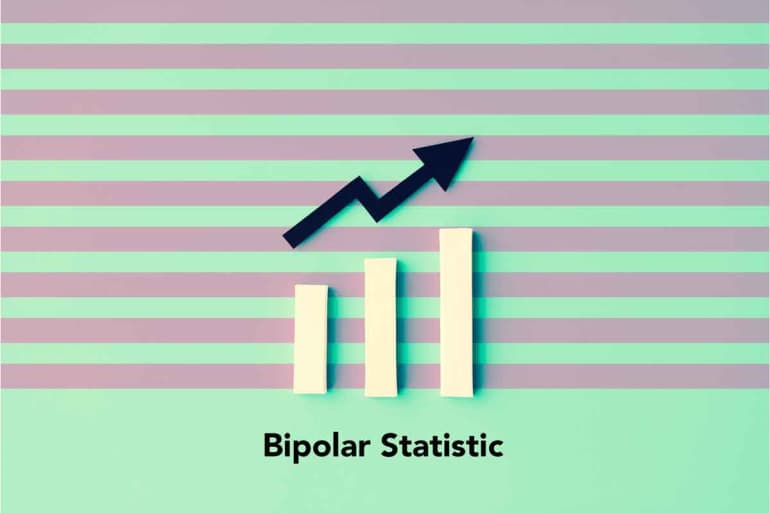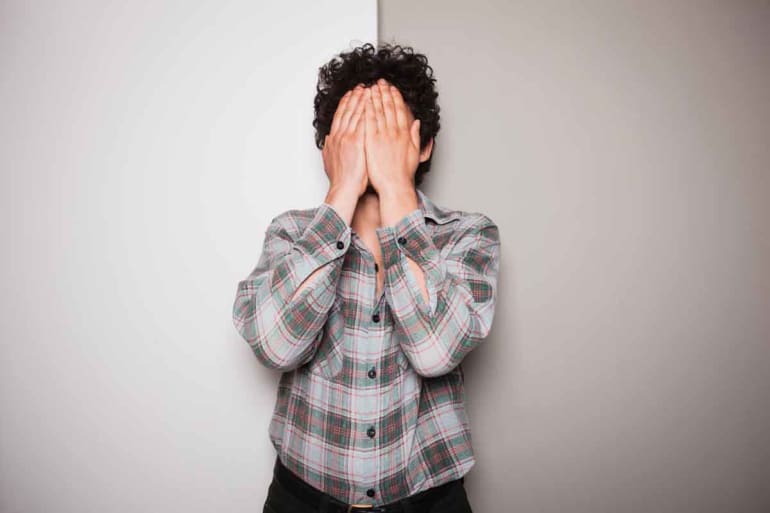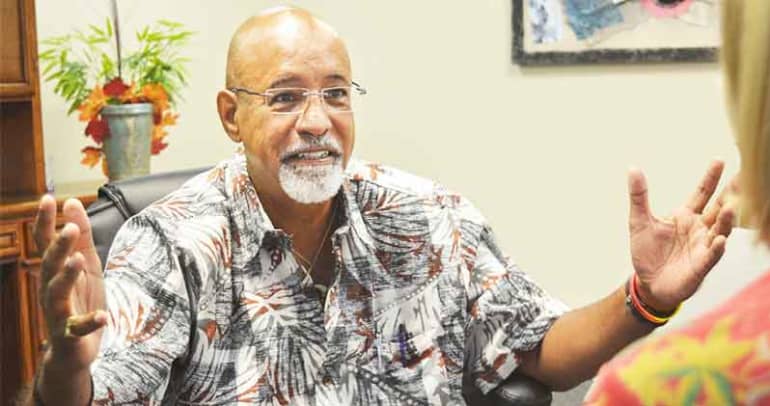What is Bipolar Disorder?
Bipolar disorder is a mental disorder characterized by drastic shifts in mood, energy levels, activity, and focus. People with bipolar experience extreme changes in their emotional state that last for periods of days or weeks. These shifts affect their ability to function effectively and carry out tasks in their daily lives.
The two types of mood episodes bipolar individuals experience are manic/hypomanic and depressive. Manic or hypomanic episodes consist of an abnormally elevated mood, excessive energy, and exaggerated happiness or irritation. Depressive episodes consist of a low mood and feelings of extreme sadness and hopelessness.
Rapid mood fluctuations aren’t limited to individuals with bipolar disorder. Many people experience shifts in their mood or temper but these changes usually last hours rather than days. Sudden bursts of happiness, frustration, or sadness aren’t indicative of bipolar disorder; they’re normal human experiences.
Bipolar disorder, on the other hand, consists of mood episodes that last days, weeks, or months. These episodes often cause people to make decisions they wouldn’t make under normal circumstances. They also have a difficult time functioning because of their extreme shifts in mood.
Continue reading to learn about bipolar disorder, signs and symptoms of the condition, how to treat it, and more.
Is Bipolar a Mood Disorder?
Individuals with mood disorders experience emotional states (or moods) that are distorted or inconsistent with their situation. These extreme and sometimes erratic moods affect their ability to function in daily life. Mood disorders include conditions like major depressive disorder, seasonal affective disorder, and more.

The Diagnostic and Statistical Manual of Mental Disorders (DSM-5) classifies bipolar disorder as a mood disorder. It includes all three types of bipolar disorder as well as disorders related to bipolar. The extreme shifts in emotional state qualify the condition as part of the greater category of mood disorders.
Are Bipolar and Depression the Same?
The DSM-5 classifies both bipolar and depression as mood disorders. Bipolar and depression are not the same, though. Although there are some similarities between the two conditions, there are also a few notable differences.
Depression, referred to as major depressive disorder or clinical depression, is characterized by severe and overwhelming feelings of sadness and hopelessness. There are a few different forms of depression, all based on the person’s pervasive low mood.
People with bipolar disorder experience periods of depression, called depressive episodes. They have the symptoms of major depressive disorder and these symptoms last for days, weeks, or months at a time.
The main difference between bipolar disorder and depression is that individuals with bipolar shift out of the depressive episode. At the end of their depressive episode, they transition into a manic or hypomanic episode with a different set of symptoms.
Are Bipolar Disorder and Schizophrenia Related?
Bipolar disorder and schizophrenia have some similarities but they are not related. Both are a unique mental disorder and are classified as two different conditions. Individuals with schizophrenia experience far more severe symptoms than those with bipolar disorder.
For example, hallucinations and delusions are two characteristic symptoms of schizophrenia. Hallucinations involve seeing, hearing, or feeling things that aren’t real. Delusions are beliefs that an individual believes that are not true. Symptoms of schizophrenia may be so severe that a person is completely incapable of caring for themselves.
Are Bipolar People Neurodivergent?
Neurodivergent is a term typically used to describe individuals who have cognitive or learning disabilities like autism or dyslexia. It originated as a way for individuals to view their conditions as natural variations of being instead of impairments or deficits. The term has grown in popularity over the years and people wonder which conditions fall within the category.
More conditions seem to fall under the category today. Some ask whether bipolar people are neurodivergent. There’s no specific criteria for a diagnosis to be considered neurodiverse. It seems like the common understanding is that bipolar disorder is a mood disorder but not one that qualifies as neurodivergent.
History of Bipolar Disorder
The first suggestions of bipolar disorder date back to the 1850s, noted by two different psychiatrists. Jean-Pierre Faltret first described a condition he called “circular insanity” during a lecture that was summarized in a publication in 1851. Additionally, Jules-Gabriel-Francçois Baillarger noted “madness in double form,” a biphasic mental illness consisting of shifts between mania and melancholia. His paper was published in a medical journal in 1854.

Early concepts of bipolar disorder resurfaced with the studies of Emil Kraepelin, a German psychiatrist. He based his findings on the concept of cyclothymia from Karl Ludwig Kahlbaum. Kraepelin created the term “manic depressive psychosis” while observing various patients under his care.
Adolf Meyer, a Swiss psychiatrist, influenced the inclusion of a condition called “manic-depressive reaction” in the Diagnostic and Statistical Manual in 1952. It was initially categorized with depressive disorders (then called unipolar depressive disorders). Psychiatrists continued observation of the shifts between mania and depression, though, and unipolar and bipolar disorders were differentiated in the publication of the DSM-III in 1980.
After bipolar disorder made it into the DSM, understanding grew. Psychiatrists noted differences between certain bipolar diagnoses and split them into separate subtypes. The bipolar II and rapid cycling subtypes were recognized when the DSM-IV was published in 1994.
Bipolar Statistics
Bipolar disorder statistics are important to note as they provide a picture of the true extent of the condition. Bipolar disorder affects about 1 percent of the global population and about 2.6 percent of the U.S. population. The condition starts to show as early as childhood or as late as a person’s 40s or 50s, but 25 years is the median age of onset. Men and women seem to develop bipolar disorder at equal rates.

Genetics plays a significant role in the development of bipolar disorder. Current research suggests that genes are responsible for about 70 to 90 percent of the chance a person develops the condition. A child has a 15 to 30 percent chance of developing bipolar disorder when one parent has the diagnosis. Their risk increases to 50 to 75 percent when both parents have it.
Bipolar disorder also comes with serious effects. It’s the sixth leading cause of disability around the world according to the World Health Organization. Additionally, bipolar results in an average of 9.2 years reduction in expected lifespan. More than 6 percent of individuals die by suicide in the two decades following their diagnosis. A staggering 30 to 40 percent engage in self-harm behaviors.
Facts and Myths About Bipolar Disorder
Although understanding about bipolar disorder continues growing every year, there are still plenty of misconceptions and misunderstandings. Many people don’t understand how severe bipolar disorder truly is and the reality of individuals who live with it. These facts and myths about the condition are important to understand because it helps you recognize the truth about the disorder.

Myth: Bipolar episodes shift quickly
Fact: People often mistake rapid mood swings or bursts of anger for bipolar behavior. In reality, individuals with bipolar disorder experience episodes that last weeks or months at a time depending on their specific diagnosis.
Myth: Mania is an exciting and fun period
Fact: People may feel good during their manic episodes, full of energy, and able to go without sleep for long periods. It might be appealing from time to time but more often than not it’s an unpleasant experience. Sleeplessness and overstimulation lead to agitation and irritability. Manic episodes are also difficult or impossible to control, often causing unwanted outcomes.
Myth: People can stop taking their medication when their symptoms settle
Fact: Taking medication is a crucial part of treatment plans for most individuals with bipolar disorder. Medication is the main part of the reason they can manage their symptoms so it would be counterproductive to stop taking them. Individuals should never stop taking their meds without first consulting their psychiatrist.
Celebrities with Bipolar Disorder
Celebrities have been more forthcoming about their struggles with mental health in recent decades. Many celebrities with bipolar disorder feel more comfortable coming forward about their battles with mental health.

Mariah Carey
Mariah Carey received her bipolar diagnosis in 2001 following her hospitalization for a mental breakdown. She didn’t open up about the diagnosis until 2018, though, when she told People that she didn’t want to believe it. Carey now has her diagnosis under control and wants her story to reduce the stigma that others face for their own disorders.
Demi Lovato
Demi Lovato is known as a modern-day celebrity champion for mental health. They have personal experience with an eating disorder, substance abuse, self-harm, and more. Lovato learned the extent of their mental illness when they entered treatment for their eating disorder and self-harm behaviors. They were diagnosed with bipolar disorder while in the program and have since stepped up to raise awareness for others who struggle.
Kanye West
Kanye West has made front covers of magazines and tabloids for years due to his erratic behaviors. It wasn’t until 2017 that he was diagnosed with bipolar disorder, though, and he finally had an explanation for the way his mind works. West sees his bipolar disorder as an opportunity to raise awareness and understanding surrounding mental illness.
Carrie Fisher
During her life, Carrie Fisher was open about her ongoing battles with mental illness and substance abuse. She was also diagnosed with bipolar disorder at the age of 28 after years of cycling between manic and depressive episodes. Up until her passing in 2016, Fisher was a major proponent for mental health.
Signs and Symptoms of Bipolar Disorder
Bipolar disorder is characterized by two main mood episodes: mania (or hypomania) and depression. These intense shifts in mood are coupled with changes in energy, activity levels, sleeping patterns, appetite, and more. Behaviors during mood episodes are out of character compared to the individual’s normal behaviors.

Mood episodes do not cycle rapidly; they last at least a few days or weeks. The symptoms of the particular episode (whether manic or depressive) last every day, throughout most of the day, for the entire period of days or weeks.
Manic Episodes
During a manic episode, individuals feel extremely energetic. Manic episodes decrease the need for sleep and reduce the person’s appetite. They experience racing thoughts, talk fast, and tend to be distracted and all over the place. Oftentimes people try to accomplish many different and often unrelated tasks during these periods.
Manic episodes also cause them to engage in risky behavior they wouldn’t participate in outside the episode, such as risky sex, spending or giving away lots of money, eating a lot, or drinking heavily. Sometimes mania can trigger a break from reality, or psychosis, that leads to hospitalization.
Hypomanic Episodes
Hypomanic episodes are similar to manic episodes and consist of much of the same behavior. However, hypomanic episodes are less severe than full manic episodes.
Depressive Episodes
Depressive episodes are marked by a depressed mood and intense feelings of sadness, emptiness, and hopelessness. During a depressive episode, people have little to no energy and they move, think, and speak slowly. Sleeping problems, whether having trouble falling asleep or sleeping too much, are common during these periods.
Depressive symptoms include difficulties concentrating or making decisions, and they often feel unable to accomplish even the simplest of tasks. They also experience noticeable changes in appetite, either an increase or a decrease. Depressive episodes cause significant disruption in their day-to-day activities and make it hard to fulfill responsibilities.
Mixed Affective Episodes
Mixed affective episodes, also called episodes with mixed features, consist of both manic and depressive symptoms at the same time. Not every person experienced mixed affective episodes but they still are a common symptom of bipolar disorder. Individuals with Bipolar I have these episodes with mixed features.
During mixed affective episodes, people experience symptoms of both mania and depression. The exact symptoms depend on the person and the episode. For example, mixed features may include feeling sad, empty, hopeless, but also having a lot of energy or manic sleeplessness.

Learn more about post-traumatic stress disorder, an intense, pervasive, complicated condition that some develop in response to experiencing a traumatic event.
More infoHow Bipolar Works
Experts are still unclear on how bipolar works exactly. Current research and studies indicate that certain abnormalities in the brain seem to be connected with bipolar disorder. Individuals with the condition appear to have anomalies in the structures and functions responsible for emotional processing and cognitive tasks.

The amygdala and ventral prefrontal cortex are two main areas of the brain associated with bipolar. Affected functioning in these parts of the brain cause disruption to cognition and emotional regulation and an impacted ability to process risk vs. reward, especially during episodes of mania. Despite growing knowledge, though, researchers have much more work to do before they develop a full understanding of how bipolar works.
How Does Bipolar Disorder Affect the Brain?
Bipolar disorder affects the brain in various ways. One study showed that people with bipolar disorder have thinner gray matter compared to the general population. Areas with gray matter are connected to:
- Processing feelings, thoughts, and information
- Controlling senses and impulses
- Regulating motor skills (i.e. balance, reaction time, writing, speech)
The parts of the brain that control motivation and inhibition, located in the frontal and temporal regions, were impacted the most in these MRIs. Patients with a history of psychosis showed even greater deficits.
Another study revealed that individuals with bipolar disorder have a smaller hippocampus than those who do not have a mood disorder. The hippocampus handles processing and storing memories, as well as the sights and sounds associated with them. A smaller hippocampus causes symptoms such as:
- Memory problems
- Racing thoughts and paranoia
- Irritability and frustration
- Depression and depressive episodes
Bipolar disorder affects the brain’s overall chemical balance as well. Your brain functions through a delicate balance of chemicals like neurotransmitters. Neurotransmitters are chemical messengers that affect a wide range of functions in your body. These chemicals fluctuate naturally but bipolar disorder causes irregular fluctuations. Irregularities in neurotransmitter levels can cause and exacerbate symptoms of bipolar disorder.
Norepinephrine and serotonin are two neurotransmitters most commonly affected by bipolar disorder. Norepinephrine affects arousal, alertness, reaction time, and concentration. Serotonin affects feelings of happiness, anxiety, and overall mood, as well as social behavior and sleep regulation.
What Bipolar Feels Like
People with bipolar disorder oftentimes feel like they’re at the mercy of their minds and moods. Regulating emotions and behavior is an incredible challenge for people. Even when they’re treating their condition, symptoms can cause severe disruptions to daily life.
The type of episode a person is in at any given moment is the main driver for what bipolar disorder feels like. Depressive episodes and manic episodes create very different feelings and responses. The severity of the episode also determines the way the person feels.
A manic episode means bipolar feels like exhilaration and optimism. Mania often causes people to feel more creative, engaged, and entertaining. They feel ready to go and capable of handling multiple tasks at the same time. During manic episodes, individuals usually need very little sleep but get things done.
The exhilaration of mania also leads people to do dangerous and destructive things. They may participate in risky behavior, get into altercations, or spend excessive amounts of money. These behaviors are almost impossible to control until the end of the manic episode arrives.
On the other hand, a depressive episode means bipolar feels like sadness and hopelessness. It’s the crash that comes after the excitement. Depressive episodes leave people with little energy, disconnected from loved ones, and uninterested in their usual activities. They feel sluggish and mopey and may feel like the depressive feelings will never end.
Until they shift back into a manic episode.
What Causes Bipolar Disorder?
The exact cause of the bipolar disorder is still unclear. Existing research suggests that multiple factors that contribute to the development of the condition. There is no guarantee that any one aspect causes bipolar disorder but there are certain things that increase the likelihood that it will develop.

Additionally, every individual is different. Varying combinations of factors may cause someone to develop bipolar disorder. There is no guarantee that someone will have bipolar disorder but there are some signs that may indicate its eventual presence.
Chemical Imbalances
Experts believe that chemical imbalances are the main cause of bipolar disorder. Three main neurotransmitters are responsible for the majority of brain function: noradrenaline, serotonin, and dopamine. When the levels of these chemicals are out of balance, an individual may develop some of the symptoms of bipolar disorder.
Genetics
Genetics is another primary cause of bipolar disorder. The condition seems to run in families and the more closely related two individuals are, the greater their chances of developing it. Someone is five times more likely to have bipolar disorder if someone in their immediate family has, such as a brother or sister. If both parents have it or a twin has it, the likelihood is even higher. Despite the significant correlation, researchers have yet to find the exact genes responsible for bipolar disorder.
Environmental Factors
Environmental factors are another cause of bipolar disorder. While chemical imbalances and genetics hold most of the responsibility, environmental factors may be the catalyst that triggers symptoms of the condition. Traumatic experiences are a common cause for the manifestation of bipolar disorder.
Epidemiology of Bipolar Disorder
According to an analysis of the National Epidemiological Catchment Area survey, 0.8 percent of the U.S. population experiences a manic episode at least once, and 0.5 percent have a hypomanic episode. An additional 5.1 percent of the population experienced at least one or two symptoms of bipolar disorder. This means about 6.4 percent of the population is classified as having a possible bipolar spectrum disorder.

Another analysis from the U.S. National Comorbidity Survey found that:
- 1 percent of the population meets lifetime prevalence criteria for bipolar I
- 1.1 percent meets the lifetime prevalence criteria for bipolar II
- 2.4 percent meet the criteria for other subthreshold symptoms
The presence of bipolar disorder is similar between men and women in both the United States as well as across different cultures and ethnic groups. The main differences in bipolar disorder around the globe are in an individual’s ability to access care. For example, disability-adjusted life year rates are higher in developing countries compared to the United States or Europe.
Bipolar Subtypes
Bipolar disorder is characterized by the shifts between manic and depressive. The condition is split into different bipolar subtypes depending on the length and severity of an individual’s episodes. There are three different bipolar subtypes.

Bipolar I Disorder
Bipolar I consists of manic episodes that last at least 7 days, or when manic symptoms are severe enough to require immediate hospital care. Depressive episodes also occur and usually last at least two weeks. Individuals with bipolar I also experience mixed episodes where they have symptoms of both mania and depression at the same time.
Bipolar II Disorder
Bipolar II consists of a pattern of depressive and hypomanic episodes. Hypomanic episodes experienced by those with bipolar II are not the severe, full-blown manic episodes that individuals with bipolar I experience.

There is widespread misunderstanding about Bipolar Disorder, starting with the fact that there are four types, including Bipolar I and Bipolar II.
More infoCyclothymia
Cyclothymia, also called cyclothymic disorder, is the third subtype of bipolar disorder. It’s a milder form of bipolar that is characterized by periods of depressive symptoms and periods of hypomanic symptoms which last at least 2 years. During those two years, the symptoms must last at least half the time and not subside for more than two months. The symptoms of cyclothymia, however, are not severe enough to meet the diagnostic criteria for a full hypomanic or depressive episode.
Which Bipolar is More Common?
Bipolar I and bipolar II are the two more common forms of the disorder. People are diagnosed with one of these two subtypes more frequently than other forms of bipolar. Bipolar I is a more severe diagnosis than bipolar II, with episodes of full-blown mania and depression. That doesn’t mean bipolar II is any more comfortable to live with; both forms of bipolar are serious conditions that cause significant disruption to everyday life.
Which Bipolar is Less Severe?
Cyclothymia is the least severe diagnosis of the three bipolar disorder subtypes. People with cyclothymia do experience symptoms of depression and hypomania. At the same time, their symptoms are not enough to meet the diagnostic requirements for a full-blown manic or depressive episode.
Their episodes are more mild and manageable Still, individuals with cyclothymia experience noticeable difficulties in their day-to-day experiences during their episodes. Although their symptoms are less severe than bipolar I or bipolar II, cyclothymia is still a challenging condition to live with.
Which Bipolar is Worse?
Bipolar I is the most intense diagnosis of the three subtypes of bipolar disorder. It consists of full-blown episodes of both mania and depression instead of the more mild hypomanic episodes of bipolar II or the symptoms alone of cyclothymia.
Bipolar manic episodes last at least seven days and may be so severe that the person needs hospitalization. Mania can cause a person to dissociate from reality and disconnect from their surroundings. The way a person behaves while manic resembles their normal state very little. Their manic episodes may affect their daily life, job, or relationships and could leave a lasting impact in some circumstances.
Which Bipolar Has Hypomania?
Bipolar II is the subtype of bipolar that has hypomania. Hypomania is an episode that shares symptoms with mania but the elevated mood and other symptoms are less intense. During hypomanic episodes, individuals are still energized, motivated, and hyperactive. They are overly excited and take on many things at once.
Even though hypomania is less severe than the mania of bipolar I, hypomanic episodes are still overwhelming and debilitating. The excessive energy and excitement isn’t always convenient and leads to symptoms like inability to sleep, extreme talkativeness, increase in distractibility, or excessive focus.
Most times people don’t need to be hospitalized for hypomanic episodes like those with manic episodes do. There are still some times where their symptoms may be so severe, though, that they require medical attention or intervention.

There are many misconceptions about bipolar disorder, a mental disorder that affects more than 5 million Americans. Learn more about the true definition of bipolar manic depression and how to manage it.
More infoWhich Bipolar Has Psychosis?
Bipolar I is the subtype of bipolar that has psychosis. Psychosis is a severe mental state where someone’s thoughts and emotions are so affected that they lose touch with reality. During an intense manic episode, individuals with bipolar I experience a highly elevated mood, extreme activity level, and inflated sense of self.
Sometimes these exhilarating manic episodes progress to the extreme and lead to an episode of psychosis. They disconnect with reality and cannot differentiate between what is real and what they’re imagining. At least half of the people with bipolar disorder will experience one or more symptoms of psychosis over their lives.
Sometimes people with bipolar II experience symptoms of psychosis but it happens very rarely. Hypomania doesn’t usually advance to the point of psychosis. It occurs most often in individuals with bipolar I.
Which Bipolar Has Hallucinations?
Bipolar I is the subtype of bipolar that has hallucinations. Hallucinations are physical sensations that a person experiences but that aren’t real. These include visual (seeing), auditory (hearing), and tactile (feeling) sensations that seem real to the person but are not happening.
When someone is experiencing an extreme manic episode that verges on psychosis, it’s often accompanied by hallucinations. Some examples include feeling like bugs are crawling on the skin, hearing voices, or seeing “shadow people”. These imagined sensations are part of what leads to psychosis or their separation from reality.
How is Bipolar Disorder Diagnosed?
Since bipolar disorder is a mental disorder, a psychiatrist is most likely to diagnose it. Diagnosing the condition is done using a few different evaluation approaches. How is bipolar disorder diagnosed?

- Physical exam: Your physician may first conduct a physical exam and order lab tests to determine whether any pre-existing medical conditions are causing your symptoms.
- Psychiatric evaluation: A psychiatrist assesses the individual to learn more about their feelings, thoughts, and behavioral patterns. They may also ask the person to fill out a questionnaire or written psychological self-assessment. The psychiatrist may ask your family for information about your symptoms as well, with your permission.
- Mood tracking: The psychiatrist may ask you to track or record your moods daily for a period, as well as other symptoms such as sleep patterns. Data you track can help ensure that your bipolar disorder is diagnosed correctly.
- Bipolar disorder criteria: There is a list of criteria for bipolar disorder outlined in the Diagnostic and Statistical Manual of Mental Disorders, set by the American Psychiatric Association. Your physician or psychiatrist will also consult this list as a way to diagnose bipolar disorder.
Can Bipolar Be Cured?
Bipolar cannot be cured, much like other mental illnesses. There is no currently known way to cure a person’s bipolar disorder. Thankfully, though, there are ways to treat bipolar disorder. Treatment options are widely available to individuals living with the condition. They can learn to manage their symptoms and live a healthy, happy life engaged with the world around them.

How Do You Treat Bipolar Disorder?
The main methods used to treat bipolar disorder are medication, therapy, and lifestyle changes. Using a combination of these approaches is the best way to manage the condition. Trying to use only one or two modalities will not provide the comprehensive treatment needed to manage bipolar disorder.
Additionally, there is no one right way to treat bipolar disorder. Every person has a unique life experience that affects the way their symptoms manifest. Effective treatment always considers every person on an individualized basis. What works for one individual may not work for another.
Medication
There are a few types of medications approved to treat bipolar disorder. Medications designed for the condition are called mood stabilizers and do exactly as their name implies. Bipolar medication stabilizes an individual’s moods, which reduces the severity of their manic and depressive episodes.
At the same time, medications affect everyone differently. They cause side effects that can cause mild to moderate discomfort. It’s important to work with a psychiatrist when determining which medication is best to keep side effects in check and limit the more intense reactions.
Therapy
Using medications to manage moods is only one part of the puzzle. Therapy is another crucial approach used to treat bipolar disorder. Individuals learn coping skills and tools to manage their moods and limit the severe impacts that these drastic shifts can cause. Therapy is also a great way to work through other issues that affect bipolar disorder, such as substance addiction, trauma, interpersonal relationships, and more.
Lifestyle Changes
Many people underestimate the significant impact that lifestyle changes can have on bipolar disorder. Habits play a noticeable role in overall mental health. Important factors to consider are getting good sleep, exercising regularly, eating a healthy diet, and maintaining a consistent schedule. Reducing drug and alcohol use, participating in enjoyable hobbies, and spending time in a supportive environment are also helpful changes to make.
What Happens When Untreated?
Bipolar disorder tends to get worse the longer a person goes without seeking treatment. Leaving bipolar disorder untreated can lead to many dangerous effects. Some of the dangers of untreated bipolar include:
- Limited or complete loss of ability to work
- Excessive stress on or inability to maintain personal relationships
- Substance abuse or addiction
- Self-harm or suicide
Treatment for bipolar disorder equips individuals with the tools they need to manage their moods so they can live their lives. They will always live with bipolar disorder but treatment gives them the ability to engage with life as fully as possible.
Are Bipolar Meds Addictive?
Bipolar meds are not addictive in the sense that illicit recreational drugs are addictive. They’re not used for recreational purposes and do not cause a “high.” Bipolar meds do lead to dependence, though, meaning the person needs the medication to function normally. Depending on the type of medication used, individuals can develop physical or psychological tolerance or both. If they stop using their medication suddenly and without medical supervision, they will experience some severe and dangerous effects.
Where to Get Help
Help for bipolar disorder is available throughout the United States. Depending on what you’re looking for from your care and whether you have other co-occurring disorders, certain facilities may be more equipped to help you.
For example, if you have a dual diagnosis, meaning both bipolar disorder and a substance dependence problem, Hawaii Island Recovery can help. Our facility is located on the beautiful big island of Hawaii, providing a serene and tranquil environment where your recovery is your primary focus.
We understand the difficulties of living with bipolar disorder and the intricacies of managing your condition, but we’re here to help every step of the way. To learn more about the treatment programs we offer, call us at 877-721-3556 to speak with an admissions specialist today!
Get Help Today!
If you or a loved one need help, call Hawaii Island Recovery toll-free right now.
866-390-5070 Hawaii Island Recovery
Hawaii Island Recovery 










